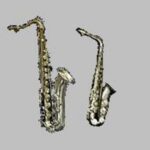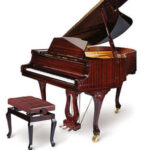Alternate and chromatic fingerings are often necessary on saxophone in order to accommodate fast technical passages. Even when the passages in question are not particularly fast, it is good to get in the habit of using the appropriate fingering, even if it is one you are not completely fluent in yet. Before we get into the alternate fingerings and when to use them, it is important to realize that there is not always one right answer all the time in determining which fingering to use. There are several different schools of though on when to use certain fingerings, and all of them ground their argument in valid points. During my undergraduate years I had two saxophone professors, and it was not uncommon for each of them to tell me a different way to finger the same passage. In the end, it is up to the player (or in the instance of students, a teacher) to use his/her best judgment in determining which fingering to use. However, there are always certain hard a fast rules that saxophonist must follow when making those judgments.
Bb
This is often the one of the first alternate fingerings that a young student will encounter. There are several different fingerings, and each one has it’s uses.
Bis Bb – This is the most used Bb fingering. To use it, simply finger B, and with your first finger, add the little key right below the key you’re already using. You push two keys down with the same finger. Think of this fingering as your first choice fingering. When one becomes accustomed to it, it is far easier to use than the side fingering.
When not to use it- When there is a B-natural directly next to the Bb/A#. You are not allowed to slide your finger between the B and Bis Bb fingering.
Judgment usage- Between Bb and C. Many saxophonists spend so long flipping between B and C before they learn the chromatic fingering that flipping between Bis Bb and C isn’t usually a huge deal. See the note below for Side Bb for further explanation.
Side Bb- This is most often the first Bb fingering a saxophonist will learn. It uses the A fingering, and adds the bottom side key of the right hand.
When to use it- If Bb is directly next to B-natural. I also prefer to use this fingering when Bb is next to C.
Judgement usage- When Bb is neighbored by a note that uses any right hand fingers, and followed by C (ex. D-Bb-C). It may be awkward to lift the right hand up, and at the same time push the side key down. The Bis fingering would also make it awkward to flip to the C. I would prefer to use the side key, and avoid the flip. A skilled saxophonist will be able to make either option sound reasonably clean.
1-1/1-2 Bb (may also be known as 1-4/1-5) – This is the least common fingering for Bb, and also the fingering that yields the poorest intonation and tone quality. It is simply the first finger of the left hand and either the first or second finger of the right hand.
When to use it- In fast arpeggiated passages (think Bb major arpeggio: Bb-D-F-Bb-F-D-Bb). It may also be used in fast passages where the Bb is between notes that use the right hand fingers (ex. F-Bb-E-Bb-B).
When not to use it- Basically whenever you can avoid it. This is the Bb fingering that is least in tune, and should only be used in fast, technical passages as described above. In slow passages, the bis or side Bb should give you the cleanliness and intonation needed.
F#
This is probably the first chromatic fingering a young student will probably learn. There is only one alternate fingering to F#, which is called the chromatic fingering. This uses the F-natural fingering, and also adds the chromatic F# key. This is used with the third finger of the right hand, and can be found on the bottom half of your saxophone. It is the one solitary key all by itself, above the right hand pinky keys, and the below the side keys.
When to use it- When F-natural and F# are next to each other.
When not to use it- If that F# is also neighbored by a note that uses the third finger of the right hand (D, Eb, low C and below). An example of this would be going F-F#-D, or vice versa. If you have a passage that uses the third finger of the right hand, you will not be able to get that third finger over to use the chromatic F# fingering. You can only try to make the F-natural to F# as clean as you can.
Judgment usage- When you have the F# also neighbored by a note that uses the second finger of the right hand, which would just be E. An example of this would be F-F#-E, or vice versa. You either have to flip between the F and F# or be able to lift the second finger and put your third finger down at the same time. Either scenario can lead to slightly awkward fingerings, and passages that are more difficult to get clean.
C
This is another chromatic fingering that a student should learn before reaching the high school level. The chromatic fingering uses the B fingering, and adds the middle side key of the right hand.
When to use it- When you have B and C directly next to each other.
When not to use it- If the note on the other side of the C also uses another side key (high E/F).
Judgment usage- When the note on the other side of C is anything other than C or C#. Again, lifting any extra fingers and at the same time pushing the side key down can be difficult to clean. At the same time, it is also awkward to flip between the B and C.
D
The next fingerings are some lesser known fingerings, and are usually not found on the fingering chart of beginning method books. The alternate D fingering uses the fingering for C, and then adds the second palm key (the one used for Eb). You can also take away the second finger, and use just the palm key for the same result. This is used in fast technical passages that do not continue moving up past D, trills, turns, or other ornamental figures. This fingering is not commonly used outside of these circumstances.
Ab/G#
The alternate fingering for G# simply uses any of the other left hand pinky keys instead of the G# key. This is used in fast arpeggiated passages. When moving from the lower notes, you can simply keep the pinky down, when moving up and down the arpeggio. An example of this would be Db-F-Ab-Db-Ab-F-Db. The pinky would keep the C# key down throughout the whole passage.
C#
C# is often one of the notes with the poorest tone quality and intonation. To aid this, you can use what is known as long C#. Long C# uses the left hand third finger, octave key, and any of the right hand fingers. I try to use this fingering whenever I can just to improve the tone and intonation a bit. If C# is neighbored by a note that uses any of the right hand fingers, those can be simply left down. This fingering is especially useful in passages that may continually go to C#, but head back up (ex. D-C#-D-E). In a piece of music, it is also advisable to use it this fingering especially on a long note. Be careful with this fingering though. Saxophones have changed a lot throughout the years, and the tone quality and intonation improvement may not be of much benefit on your saxophone. This fingering is also not used on soprano.
High E and F
There is a difference of opinion as to when to use the alternate high E and F fingerings, otherwise known as the front fingerings. To use the high E fingering, use the left hand first finger to push the very first key encountered for the left hand. This is located above the B key. Add the second and third fingers in the left hand, and the octave key. For the front F fingering, take the third finger away so you use the second finger. There is often a noticeable change in tone quality when using the front E and F fingerings. This is why it may be advisable to only use these fingerings as a passageway into the altissimo fingerings. The other school of though is to do what makes most mechanical sense. This would make the front E and F fingerings applicable when either note is accompanied or surrounded by C (ex. C-E-F-C).
Some of these fingerings may not be appropriate for a young student to learn. As a student develops and gains more musical maturity, the introduction of alternate and chromatic fingerings will only help in his development of technique. Gaining fluency in these fingerings takes practice, and knowledge of all the fingerings is necessary in technical development. Learning when to use each fingering within the context of the music takes time. This is best done under the guidance of a qualified teacher. The above guide is only an outline of the alternate and chromatic fingerings found on saxophone. This does not delve into the altissimo range, as that is another topic entirely. It is also impossible to give an example of every musical passage that you would encounter these fingerings in. It is important to look at the music thoughtfully to choose a fingering that will make sense in the context of the music and what also makes mechanical sense.





